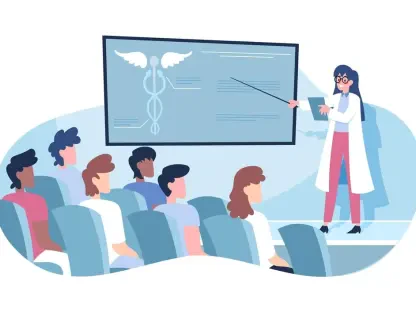Introduction
The staggering reality of healthcare costs in the United States paints a troubling picture: spending per person reached $13,432 in recent years, far outpacing other high-income nations, with projections estimating a rise to $24,200 by 2033, highlighting a critical need for innovative solutions. This financial burden, coupled with accessibility barriers that leave over a quarter of adults delaying or avoiding care due to cost, underscores the urgency for change. The potential of artificial intelligence (AI) and machine learning (ML) to transform this landscape offers a glimmer of hope, promising to address inefficiencies and expand access to quality care.
This FAQ article aims to explore how AI can make healthcare more affordable and accessible by answering key questions surrounding its application. Readers can expect to gain insights into specific areas where AI is making an impact, supported by real-world examples and data, while also understanding the challenges that remain. The scope covers cost reduction mechanisms, quality enhancements, and the expansion of care delivery, providing a comprehensive look at technology’s role in reshaping healthcare.
By delving into these topics, the goal is to clarify complex concepts and offer actionable understanding for anyone interested in the intersection of technology and public health. This discussion will navigate the promises and limitations of AI, ensuring a balanced perspective on its transformative potential.
Key Questions or Topics
How Does AI Address the High Cost of Healthcare in the United States?
Healthcare costs in the United States remain a pressing issue, with federal expenditures hitting $1.9 trillion in recent data, accounting for a significant portion of national spending. This financial strain, compounded by projections of federal debt reaching 156% of GDP by 2055, highlights the urgency of finding sustainable solutions. AI and ML emerge as tools to tackle these costs by targeting inefficiencies and waste that inflate expenses across the system.
One major avenue for cost reduction lies in productivity gains, particularly in administration, which consumes 15-30% of total healthcare spending—much higher than in peer nations. AI systems are being utilized to streamline processes like billing and claims management, while also detecting fraud, estimated to cost federal programs $100-200 billion annually. For instance, legislative proposals like the Medicare Transaction Fraud Prevention Act showcase bipartisan support for using AI to curb fraudulent transactions, demonstrating its practical impact.
Additionally, studies suggest that wider adoption of AI could save between $200 billion and $360 billion annually by automating repetitive tasks and optimizing resource allocation. These savings could alleviate some fiscal pressure, though experts caution that technology alone cannot resolve deeper systemic issues. The evidence points to AI as a valuable ally in cost containment, provided it is paired with structural reforms.
In What Ways Can AI Improve the Quality of Medical Care?
Beyond cost, the quality of healthcare stands as a critical concern, with many patients facing delays in diagnosis or treatment due to systemic bottlenecks. AI offers promising solutions by enabling earlier detection of ailments and reducing reliance on costly, invasive procedures. This capability addresses not only patient outcomes but also the economic burden of late-stage interventions.
A notable application is in managing chronic conditions, which affect two-thirds of Medicare recipients and drive significant expenses. AI tools can analyze vast datasets to identify patterns and recommend interventions sooner, potentially saving taxpayer money, as noted by policymakers advocating for tech-driven healthcare strategies. This shift toward proactive care marks a significant improvement over traditional reactive models.
Moreover, AI is revolutionizing drug development, a process historically costing around $1 billion and spanning over a decade with high failure rates. Companies have leveraged AI to drastically cut timelines and costs, developing treatments for complex conditions in under 18 months for a fraction of the usual expense. Industry leaders predict that such advancements could halve discovery times, paving the way for more affordable medications and better health outcomes.
How Does AI Enhance Access to Healthcare Through Autonomous Care?
Access to healthcare remains elusive for many, particularly in underserved regions or amid physician shortages projected to range from 37,800 to 124,000 over the next decade. AI-driven autonomous care, where systems deliver medical services without direct clinician involvement, presents a viable solution to bridge these gaps. This approach leverages technology to extend the reach of healthcare services where human resources are limited.
AI tools, capable of processing medical data continuously, achieve high diagnostic accuracy in complex cases, often surpassing experienced physicians with rates up to 85%. Such systems act as virtual team members, providing second opinions and personalized treatment plans, especially for patients lacking primary care providers. Government agencies have adopted these technologies for research and patient monitoring, tailoring care to individual needs with remarkable precision.
Real-world initiatives, like hospital platforms offering AI support to patients without regular doctors, illustrate how technology can fill critical voids in service delivery. This expansion of access is vital for addressing disparities and ensuring that more individuals receive timely care, regardless of location or socioeconomic status. While challenges like public trust persist, the potential to mitigate shortages through autonomous systems is undeniable.
What Challenges and Limitations Does AI Face in Transforming Healthcare?
Despite its promise, AI’s integration into healthcare is not without hurdles, particularly around public perception and systemic constraints. A significant portion of the population—around 60% according to recent surveys—expresses discomfort with providers relying on AI for diagnosis and treatment recommendations. This skepticism poses a barrier to widespread adoption and must be addressed through education and transparency.
Furthermore, while AI can drive substantial cost savings and quality improvements, it is not a standalone fix for healthcare’s deeper inefficiencies. Experts emphasize that without complementary reforms, such as policy changes to address administrative bloat, the full benefits of technology may remain unrealized. The risk of overselling AI’s capabilities could also undermine trust if expectations are not met with tangible results.
Balancing innovation with realistic goals is essential to navigate these limitations. Policymakers and healthcare leaders must work collaboratively to build frameworks that integrate AI thoughtfully, ensuring that technological advancements align with patient needs and systemic improvements. Only through such a balanced approach can the true potential of AI be harnessed effectively.
Summary or Recap
This exploration of AI’s role in healthcare highlights several critical insights, from cost reduction through productivity gains to quality enhancements via early detection and drug development. The technology’s ability to provide autonomous care stands out as a key mechanism for improving access, particularly in addressing physician shortages and reaching underserved populations. These advancements, backed by data estimating annual savings of hundreds of billions, underscore AI’s transformative potential.
Key takeaways include the necessity of pairing AI with broader reforms to tackle systemic inefficiencies and the importance of addressing public distrust to ensure adoption. The real-world applications, such as fraud detection systems and rapid drug development, provide concrete evidence of impact, while also revealing areas for further improvement. Readers are encouraged to consider how these developments could influence healthcare delivery in various contexts.
For those seeking deeper knowledge, exploring reports from healthcare technology forums or policy discussions on AI integration offers valuable perspectives. Engaging with resources from industry leaders and governmental agencies can provide additional clarity on emerging trends and legislative efforts shaping this field.
Conclusion or Final Thoughts
Reflecting on the discussions held, it becomes evident that AI and ML have carved a significant path toward alleviating the burdens of healthcare costs and access barriers in the United States. The journey showcases how technology tackles inefficiencies, enhances care quality, and bridges service gaps, even as challenges like public skepticism linger in the background.
Moving forward, stakeholders are urged to prioritize building trust through transparent communication about AI’s capabilities and limitations, ensuring patients feel confident in tech-driven care. Collaborative efforts between innovators, policymakers, and healthcare providers stand as the next vital step to integrate these tools effectively, crafting a future where affordability and accessibility in healthcare are no longer distant goals but achievable realities.









